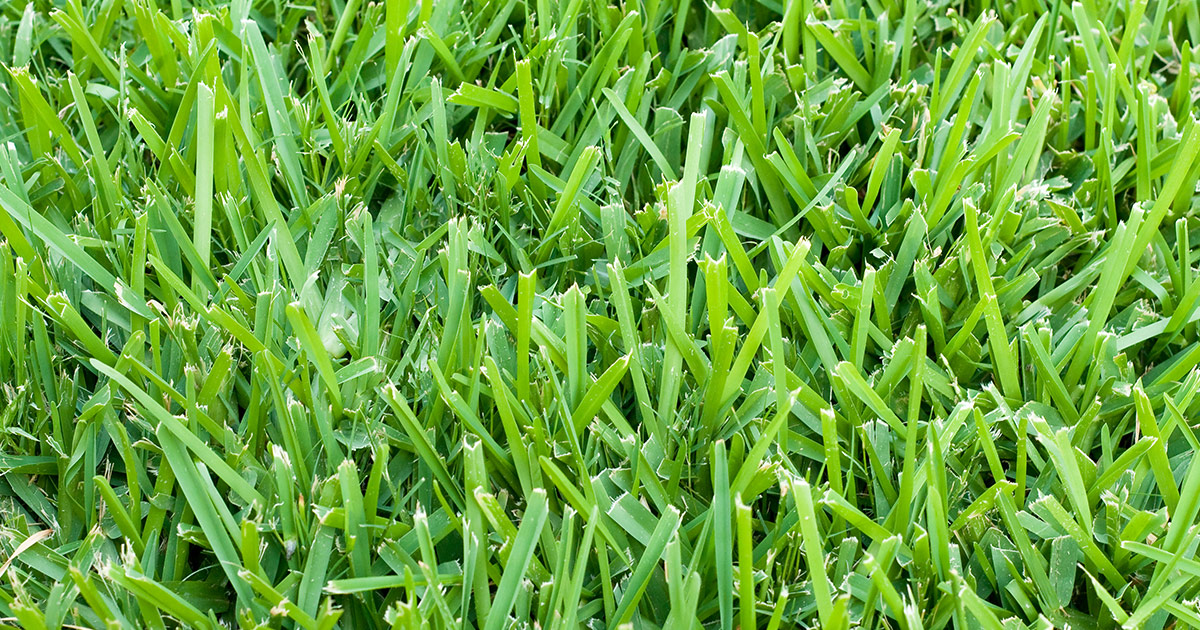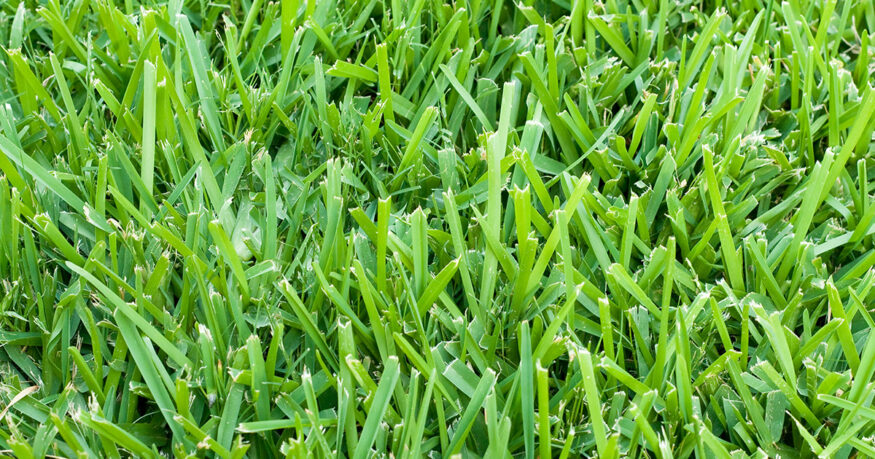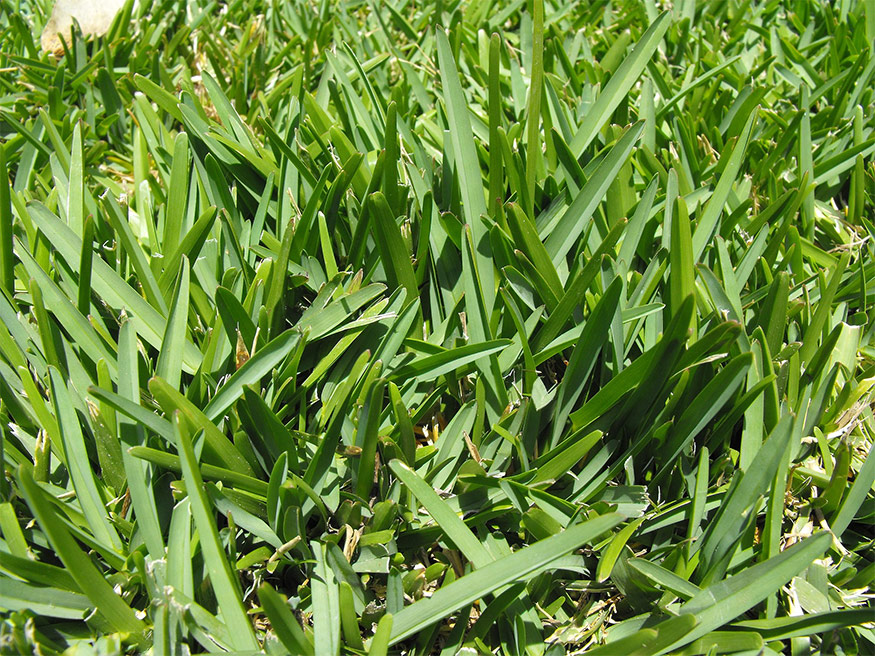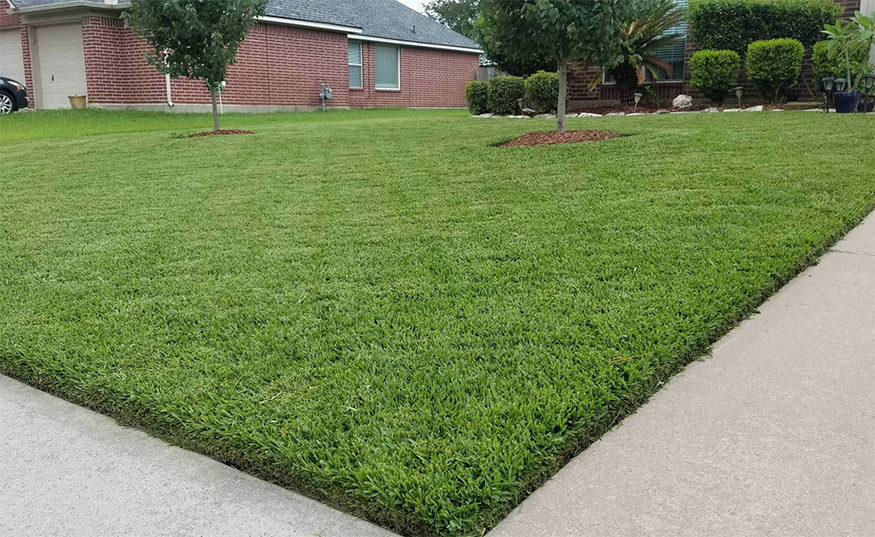St. Augustine grass is one of the most shade-tolerant warm-season grasses. It establishes quickly and looks great with proper maintenance. But it requires a high degree of care and is not the most traffic tolerant.
In this guide, we’ll look at important St. Augustine grass characteristics to help you determine if it’s right for your yard. We’ll also tell you everything you need to know to care for this warm-season grass using our helpful lawn care calendar.
St. Augustine Grass Overview
| Also Known As | St. Augustinegrass; Stenotaphrum secundatum |
| Type of Grass | Warm season perennial |
| Optimal Zones | Southern coastal |
| Root Structure | Shallow |
| Winter hardiness | Very poor |
| Heat tolerance | Excellent |
| Shade tolerance | Good |
| Water Requirements | Moderate |
| Drought Tolerance | Moderate to High |
| Self Repair Capacity | Moderate |
| Overall Maintenance Requirements | Moderate to High |
The History of Stenotaphrum secundatum
St. Augustine grass is one of the few modern turf grasses that is native to North America. It grows naturally throughout the gulf of Mexico as well as in the Mediterranean.
Once people discovered this grass, it spread quickly throughout the world. By the 1800s, St. Augustine grass was a common sight along the coast in the American south, Hawaii, Africa, and South America. By 1840 it was also a common feature in Australia and New Zealand.
In the 1930s, researchers started developing variants of St. Augustine. The dwarf varieties they created can tolerate much lower cutting heights while cold-tolerant cultivators allow the grass to be used farther north.
The Floratam variety was developed in 1973 and remains the most popular type of St. Augustine used today. It is an aggressive spreader with a coarse texture that grows best in warm, sunny locations. Like other varieties, it is a good choice for home lawns in the hot south and in warm coastal locations.
St. Augustine Grass Characteristics
St. Augustine establishes and grows very quickly, making it a great choice for new lawn installations. But it is only an option in certain climates and when specific needs are met.
To help you decide if St. Augustine grass is right for your yard, let’s take a closer look at the characteristics of this species.
Type of Grass
St. Augustine is a perennial warm-season grass. “Perennial” meaning it comes back every year. And “warm season” meaning it does most of its growing when temperatures are hot.
Like zoysia grass and bermuda grass, St. Augustine grows the most in the summer. In non-tropical climates, it goes dormant in the cooler months.
Optimal Zones
St. Augustine is best suited for tropical and subtropical climates. In the US, it’s a popular turfgrass in Florida and the deep south. Certain cultivators bred for drought resilience are used throughout the South West and in Southern California. Because of its sensitivity to cold, it is not a great choice for transition zones or northern regions.
Root Structure
The roots of St Augustine grass only penetrate about 6 inches deep. Despite this, it has a good drought tolerance. It will enter into semi-dormancy quickly under drought conditions but cannot survive for extended periods.
Winter Hardiness
The biggest weakness of this grass is its lack of cold tolerance. It does not perform well if temperatures dip into the 30s. If temperatures drop below 25, it will die off completely. In general, St. Augustine is only a good choice for climates that rarely, if ever, see freezing temperatures.
Even in warmer climates, St. Augustine grass will go dormant and turn brown if soil temperatures dip below 55 degrees.
Heat Tolerance
St. Augustine prefers very hot climates. Most growth occurs when daytime temperatures are between 80 and 100 degrees.
Shade Tolerance
This grass has the best shade tolerance of the warm-season grasses. Most varieties can handle partial shade and certain cultivators can tolerate as little as 3 hours of direct sunlight each day.
Water Requirements & Drought Tolerance
St Augustine grass is fairly drought tolerant despite its shallow root system. It will enter semi-dormancy quickly under drought conditions. But compared to bermudagrass, it cannot survive for as long without water.
This grass requires about 1 inch of water per week to maintain a lush, green appearance. This is on par with most warm-season grasses. It performs best with deep, infrequent waterings.
Self Repair Capacity
St. Augustine grass grows rapidly via above-ground stolons. However, it does not produce underground rhizomes like other warm-season species. Because of this, its self-repair capacity is limited when above-ground growth is worn down to the soil level.
Most varieties have a moderate traffic tolerance and will perform well under normal use for home lawns. But this grass is not a good option for high-traffic zones.
St. Augustine Grass vs Bermuda Grass
St. Augustine grass (Stenotaphrum secundatum) and Bermuda grass (Cynodon dactylon) are two popular warm-season grasses commonly used for lawns, sports fields, and golf courses. While both grasses are well-suited to warm and humid climates, there are some important differences between the two.
One of the main differences is their appearance:
St. Augustine grass has a broader, coarser blade and a darker green color than Bermuda grass.
Bermuda grass, on the other hand, has a finer blade and a lighter green color. St. Augustine grass also tends to grow taller than Bermuda grass, which can be a benefit for homeowners who want a lush, full lawn.
Another important difference is their maintenance requirements. St. Augustine grass is less drought-tolerant than Bermuda grass and requires more water to stay healthy. However, it is more shade-tolerant than Bermuda grass, making it a good choice for lawns with some shade.
Bermuda grass, on the other hand, is more drought-tolerant and requires less water. It also has a higher tolerance for foot traffic, which makes it a popular choice for sports fields and golf courses.
St. Augustine Grass Lawn Care Calendar
Keeping St. Augustine looking great requires a decent amount of work, especially in cooler climates.
New lawns can be installed via sod, plugs, or sprigs, but seed is not an option with this species. The best time to plant St. Augustine grass is in the late spring. Some cultivators can also be planted in late summer, but this needs to be done at least 90 days before the first frost.
Brand-new lawns can be mowed after two weeks. At this point, you can begin following our St. Augustine grass lawn maintenance plan, below.
Spring Care
St. Augustine grass will begin to green up and start growing in mid to late spring. But lawn maintenance will need to begin sooner than this.
Mowing
The first mow of the season should take place right before the grass begins to green up in the spring. Set your mower lower than normal—to about 2 inches high. Use a mower bag to collect the dead cuttings to avoid adding to the thatch.
Once the grass begins growing, continue mowing at a height of about 2 1/2 inches every week. Leave fresh cuttings on the lawn to provide nutrients.
St. Augustine lawns can be mowed with a rotary or push mower. But a sharp blade is necessary in both cases. If you notice tearing and browning at the grass tips, your mower blade is not sharp enough.
Fertilization
Fertilization should only be done in the spring if there is zero risk of freezing weather. St. Augustine grass that is encouraged to grow too quickly before frost will sustain damage.
Waiting until after May to fertilize is the best practice in most cases. This is, however, the best time to have a soil test done to evaluate missing nutrients.
Weed Control
Pre-emergent herbicide should be applied early in the spring, around mid-February to mid-March. Applying again in late April or early May will help further control weeds through the rest of the year.
Post-emergent weed killers should not be applied until after the grass is fully greened up. In the meantime, pull troublesome weeds by hand or use spot treatments.
Watering
Irrigation is generally not needed in spring assuming at least 1 inch of rainfall per week. When supplemental watering is needed, water deep, up to 1 inch at a time.
Pests and Disease Control
St. Augustine grass is highly susceptible to chinch bug and mole cricket damage. Unless the damage is severe, however, treatments should be delayed until summer when they will be more effective.
You should also check for excessive white grub activity by cutting a square of sod and peeling it back. More than 6 grubs in one square foot is a sign that treatment is needed. Use an insecticide spray in late spring.
Disease is typically not an issue this time of year.
Aeration and Dethatching
Spring is the best time to have your lawn aerated to avoid compact soil. Aerated soil is better able to accept nutrients and water. Spring aeration should be done right before the second application of pre-emergent weed control.
St. Augustine grass is prone to thatch buildup. If your lawn has over ½ inch of thatch, use a dethatcher with 2 to 3-inch blade spacings. Narrower spacings will damage the lawn.
Summer Care
Summer is when St. Augustine grows the most. It will need careful watering, fertilizing, and mowing to thrive.
Mowing
Set your mower height between 2 ½ and 4 inches for the summer. You can typically get away with shorter heights early on but should aim for closer to 4 inches during the heat of the season. This will help reduce stress and protect the root system.
St Augustine growing in shade will perform better if left at 4 inches all summer long.
This grass can grow very rapidly this time of year. Mow as often as needed to avoid taking more than ⅓ of the leaf height off at a time.
As always, be sure to keep a sharp blade on your mower for the best results.
Fertilization
In early summer, apply nitrogen fertilizer at a rate of ½ to 1 pound per 1,000 square feet. Sandy soils will need the higher amount while clay soils will need the lower one. Based on the soil test you did in the spring, choose a product with high or low phosphorus and sulfur amounts.
In mid-summer, fertilize with nitrogen at the same rate, but assure the mix also contains high potassium. Again, choose the phosphorus amount based on your soil test.
In early August, apply another round of nitrogen and potassium fertilizer as you did in mid-summer. Potassium is important in helping St. Augustine grass survive the winter.
Watering
Only water St. Augustine grass when it shows signs of moisture stress. It will take on a bluish-green color and won’t bounce back when walked on in the evening.
When this happens apply ¾ to 1 inch of water in a single watering. Early morning is the best time to do this.
In periods of no rainfall, you will likely have to water once a week. But it’s best to let the grass tell you when conditions are too dry.
Weed Control
Apply broadleaf herbicide in the early summer after the grass is fully greened up but before daytime temperatures get over 90 degrees. This is only necessary if weeds are a problem. Choose a product safe for St. Augustine.
Alternatively, you can pull weeds manually or use spot treatments as needed.
Pest and Disease Control
Pests can be a big problem for St Augustine in the summer. The most common suspects are:
- Mole crickets
- Chinch bugs
- Grubs
- Nematodes
- Spittlebugs
- Ground pearls
Each requires its own specific treatment, but most can be targeted this time of year. Keep an eye out for damage and treat only when necessary. If chinch bug and mole cricket damage was seen early in the year, now is the best time to treat to reduce future damage.
Large patch and gray leaf spot can occur in summer. This is typically a sign of too much moisture in the turf. Watering infrequently and just before sunrise will help.
Thatch buildup can also contribute to damage from these funguses. Only dethatch right now if your grass is not stressed and temperatures are not too high, otherwise wait until late summer.
Repair
Bare spots in lawns should be addressed in early summer by planting plugs or sprigs as needed. Some varieties can also be put in at the end of summer.
Fall/Autumn Care
The fall season is all about preparing your St. Augustine for winter dormancy.
Mowing
Continue mowing at your preferred summer height until nighttime temperatures cool to below 70 degrees. At this point, raise the mower ½ inch to allow for more leaf surface.
As usual, make sure your blade is very sharp to avoid leaf damage.
Fertilization
Do not apply nitrogen fertilizer this time of year.
The most important nutrient for fall is potassium, as this will help St. Augustine survive dormancy. If your soil test shows low potassium, add 1 pound of potash per 1,000 square feet about 5 weeks before the first expected frost.
While winterizer fertilizer can be helpful for cool-season lawns, it is not recommended for St. Augustine grass in most cases.
Weed Control
Control winter annual weeds and invasive grasses by using a pre-emergent weed control spray in September and again in late November.
Watering
Irrigation is generally not needed in the fall. However, if there is not much rainfall, you may need to supplement as you did through the summer.
Once grass goes dormant continue to keep an eye on moisture levels. If no precipitation occurs for 3 weeks, apply about ¾ inch of water when temperatures are above freezing.
Disease Control
Keep an eye out for fungus problems this time of year. Large patch, especially, can spread rapidly in moist, cool conditions. Treat with fungicides as needed.
Overseeding
Overseeding your lawn with cool-season grasses for winter color is typically not recommended for St. Augustine. Preparing this stolon-heavy grass to accept seed would require scalping the lawn, which it is not likely to recover from.
To find out how to overseed other warm-season grasses, like bermudagrass, click here.
Winter Care
St Augustine will start to go dormant as soon as soil temperatures drop below 55 degrees. After the first freeze, it will be completely dormant. From here, care revolves around assuring the grass doesn’t get too dry.
Watering
Continue monitoring moisture accumulation through the winter. If more than 3 weeks pass without precipitation, apply ¾ inch of water as soon as daytime temperatures get above freezing.



